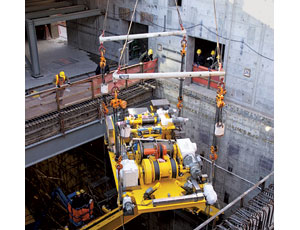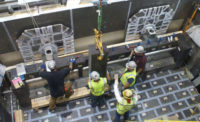With work finished in April on a major support facility, the $12.2-billion waste vitrification complex at the U.S. Energy Dept.’s Hanford nuclear waste site in Washington state is nearly 60% complete and on track to meet its mandated 2019 operating deadline, officials say.

The Hanford Waste Treatment Plant is intended to turn the site’s 56 million gallons of liquid radioactive and chemical wastes left from past decades of nuclear weapon production into vitrified glass logs. The wastes now are stored in aging underground tanks, many of which have already leaked or are in danger of doing so.
Completion of the site’s water treatment facility marks a major milestone in the project, says Bill Clements, project manager for the Frederick, Md.-based unit of Bechtel Group that is building the vitrification plant. The treatment plant will filter 500,000 gallons of water per day via underground pipes at the site—for use in treatment plant operations, either as potable, service or demineralized water. The facility also houses two chemical-addition tanks, 15 water pumps and nine process skids.
Also under way are the vitrification plant’s four main components—a waste pretreatment center, low-level and high-level waste processing facilities and an analytical laboratory—along with about 20 other buildings for support operations, maintenance, utilities and office space. “The vit plant will be largely self contained, functioning like a small city,” says Gary Olsen, DOE area project manager. The project, which began in 2001 and was originally set to operate this year, now is estimated to complete final design in 2013 and to finish construction three years later.
Bechtel spokeswoman Suzanne Heaston says the four-story analytical lab and seven-story low-level waste treatment facility are furthest along of the four structures, with exterior cladding finished and equipment now being installed. The 12-story pre-treatment facility and six-story high-level waste plant are in the erection phase, with more than 1,000 craft workers on those projects. There are 3,300 workers on the entire vitrification site.
Planning has now begun on new options for storing an estimated 4,000 vitrified waste logs from the treatment plant’s first 10 years of production. They were set to be shipped to the canceled Yucca Mountain storage site in Nevada. Each weighs 4 tons and is about 14.5 ft long and 2 ft in dia. DOE now is considering outdoor storage in casks or indoors in either a retrofitted canister storage building or in a new structure with underground vaults, say DOE officials. Construction costs could be as high as $240 million, says one published report.
DOE also is weighing expanding an existing effluent treatment facility to handle higher levels of contaminated liquids and upgrading tank farm infrastructure to better blend and deliver wastes.



Post a comment to this article
Report Abusive Comment